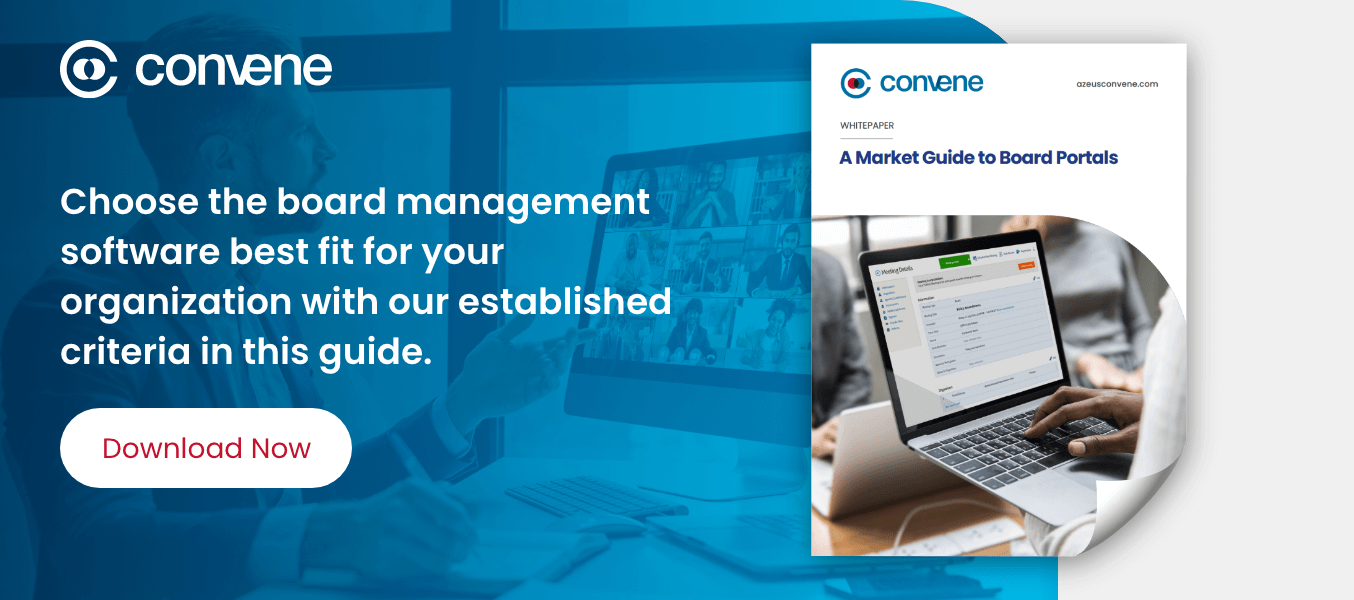Onboarding new board members is an essential stepping stone to establishing an effective board. If all focus is immediately dedicated to kickstarting the work and onboarding is downplayed, new board members are forced to dive in with a vague understanding of the company’s standing, expectations, and needs. But when onboarding is implemented strategically, new board members are provided with the right information and support to settle in — paving the way for smoother board dynamics and performance.
In this article, we will explore how onboarding can be elevated from a perfunctory welcome to a worthwhile and informative prelude for the new board members who will be collectively responsible to lead governance and steer the company to success.
Key Steps for a Successful Onboarding Process
1. Preparing for Welcoming and Onboarding
Welcoming and onboarding new board members is the first exposure of the new board members to the organization and its processes. It should be geared towards delivering an impression and experience that can positively impact the new board members’ commitment. Thus, an onboarding plan should be carefully crafted for a polished implementation.
An important step in preparation is to assess the existing onboarding practices and the information needs of the new board members. From this, the organizer can identify what can be continuously adapted or improved.
Based on the assessment, the organizer can identify the activities and documentation to be accomplished, as well as the information to be supplied. The details must be wisely segmented and timed in the onboarding plan. This includes strategizing elements such as the content, technology, schedule, materials, and work arrangement to ensure that all time and effort will be efficiently utilized.
For instance, remote onboarding is a complex process that will require the right technology. Instead of sending over tons of papers, the organizer may opt to provide a digitized onboarding pack that new board members can access on their preferred devices and digest at their own pace.
2. Setting Board Expectations
Navigating a new work environment often entails a myriad of questions, and sometimes even unease. A well-planned and executed onboarding should be designed to address any initial disorientation. It should give an overview of how they fit and what they can contribute to the organization.
One way to help the new board members is to clarify what they need to accomplish what their role demands, as well as the corresponding targets, responsibilities, and challenges, as early as the onboarding stage. When new board members are informed of what is expected from them, it can help them become highly engaged and prepared to take the next steps.
At this point, they can also deep dive into the organization’s mission, vision, and values to ensure that they can properly align their expertise and performance according to the organization’s direction.
Onboarding should not just inform, but it should also help build connections. New board members should be acquainted not only with their roles and teams but with the company culture and the people they will be working with. To ease introductions, new board member announcements and initial meetings with the other board members can be carried out.
Internal communication platforms are an efficient tool for coordinating and connecting with other board members and key staff. These interactions can be a source of experiential information that they may not come across in any reference material. They will get to know the organization through the lens of existing board members, while also nurturing board relationships at an early point.
3. Orienting New Board Members

Orientation is a vital part of the onboarding process. It is an opportunity to share essential information that can help board members deepen their understanding of the organization, and set their goals and expectations.
A tool that can sufficiently aid at this stage is an onboarding pack. It should be comprehensive and easy to navigate. As a starting point, below are some information that can be included in this reference material:
- Company Profile: This includes basic information about the organization including its history. It should provide sufficient background to the foundation of the company, the milestones it has achieved, and guiding principles including its mission, vision, and goals.
- Organizational Structure: A concrete picture of the organization’s framework and teams can further help the new board members familiarize themselves with the teams and people they may come across. It can also guide them in understanding the company workflows and information path.
- Company Policies: New board members should also be informed of the code of conduct. They should know the existing regulations for aspects including security, safety, and benefits.
- Board Information: This should give the new board members all the necessary information they need such as their roles and responsibilities, as well as how membership, voting, amendment, meetings, and other board activities are carried out. Information about the rest of the board of directors will also be beneficial for board dynamics as they can have an overview of each other’s expertise and commitments.
- Financial Information: New board members can refer to this information to understand the company’s current financial status and future projections. This is an essential material that can help them formulate questions or proposals, and aid in any decision-making activity with the rest of the board.
- Ongoing Projects and Initiatives: As the board collectively decides the company’s direction, new board members must have current information about present and future undertakings. This can help them make informed decisions and strategies.
More organizations are welcoming flexible work arrangements, and the onboarding process should adapt accordingly. New board members should be able to access information wherever they are. To facilitate this, organizations should take advantage of tools such as digitized onboarding packs. This helps ensure that all confidential company information is stored in one place, and is only viewed by those with permission.
4. Evaluating the Onboarding Process
As established earlier, the onboarding process should be tailor-fit to the needs of the new board members. It is important to check in frequently with the newcomers to examine if the plan is truly aiding them to do their roles in the organization.
There are several ways to assess the effectiveness of the current onboarding process. This can be done through casual chats or one-to-one discussions. Another common way is through formal assessments or surveys. Aside from ratings, surveys can also have sections where the new board members can provide qualitative and even constructive feedback based on their personal experience.
The feedback and assessment should provide a picture of what is working and not working for the new board member, including the content, medium, pace, and support. Progress checks give an opportunity to adjust the onboarding process at certain points, to ensure that by the end, the new board members are not launched into the task feeling disoriented and unprepared.
Onboarding should propel new board members into productive and versed leaders. By maximizing the onboarding stage as an opportunity for new board members, it reinforces that the organization listens even to minute details, and can further empower them as directors who are expected to articulate their opinion and decisions.
5. Sustaining New Member Engagement and Growth
Onboarding does not end once the new board members have all the basic and essential information. It extends to the point where the new board members have well adjusted to their roles and work arrangement. To fulfill this, steady support must be provided to the new board members.
An authentic atmosphere of support encourages continuous learning and development. This contributes to a culture of growth where the organization’s members from the top down are driven to boost their professional capacity and contribute to the overall success of the company.
This development effort will especially be helpful in the company’s compliance and governance efforts. The new board members can dedicate focus to learning the existing compliance regulations that are applicable to the business, and use them to guide their decision and strategy.
Furthermore, board evaluations can also be a means to examine the engagement of new board members. Through this, improvement areas can be identified, as well as the best courses of action to address them. Ultimately, this proactive approach to assessing board performance should be able to contribute to good governance in the long term.
How Board Portals Contribute to a Smooth and Efficient Onboarding Process
With all the information and activities that must be included in the onboarding process, it would require strenuous effort to ensure that schedules, references, and action items are monitored until completion. With the right technology, all these components can be tracked in one place for a streamlined onboarding experience.
Board management software like Convene can facilitate crucial onboarding activities, removing the need to switch between applications to access documents and meet internal teams.
- Preparing and accessing onboarding materials: Various organization documents such as project information, financial standing, and company charts can be organized and uploaded in board portals for storage and dissemination. With a secure central hub for these materials, new board members can easily access and study the documents anytime and anywhere using the device of their choice.
- Accomplishing onboarding paperwork: Board members might need to fill out and sign numerous documents as part of their records in the organization. To counter the tediousness of this task, the board technology should be able to facilitate this process efficiently while doing away with the several pages of paper to carry around. Electronic signature and document review features are integrated into applications to ease paperwork.
- Connecting with board members and personnel: Conducting initial meetings can help the new directors immerse themselves in the organization. The board software is equipped with various meeting and communication features that can help members get to know each other and prompt sharing of ideas. Moreover, user accounts in the system can be organized according to the existing classification system which helps board members further understand the organization structure.
- Tracking onboarding activities: Identifying onboarding milestones and outputs can enable a structured flow of proceedings. The right onboarding technology should aid both organizers and new board members to track what they have accomplished and what more they can expect from the process.
- Collecting feedback and evaluating the onboarding experience: From time to time, new board members must be consulted about their perceived effectiveness of the onboarding process. Board management software allows users to conduct assessments with several options to collect both quantitative and qualitative feedback. This can help identify the adjustments needed in the onboarding process.
Streamline Your Onboarding Process for New Board Members with Convene

Onboarding serves as the organization’s first opportunity to be introduced to the new board members. It does not end with simply laying down information, but it is a continuous, progressive process that can take days, weeks, or months. Notwithstanding, the ultimate goal of onboarding is to provide a positive, helpful experience for new directors as they start to participate in board meetings and make decisions towards the organization’s success.
Convene is a board management software that is designed to smoothly facilitate board meetings and collaboration. It enables organizations to conduct their internal workflows, including onboarding activities, in one secure, comprehensive platform.
Schedule a demo now and see how Convene can efficiently facilitate your organization’s onboarding process.
Mikaela joined the Convene team as a Proposal Writer which exposes her to the evolving and specific board meeting management needs of organizations worldwide. She utilizes her experience in writing about technology and working with various stakeholders to provide tailored content that helps promote productivity and efficiency. She graduated with a bachelor's degree in Development Communication from the University of the Philippines - Los Baños.











